“Constant current LED strips deliver a fixed current ideal for consistent brightness and are perfect for precise, detailed lighting. Constant voltage LED strips provide stable voltage, suited for easier installations and flexible configurations. Understanding these differences clearly helps you select the ideal LED strip type for your project.”
What Are Constant Current and Constant Voltage LED Strips?
Having personally installed both constant current and constant voltage LED strips, I can share clear insights to help you understand their fundamental differences.
Defining Constant Current LED Strips
Constant current LED strips operate by delivering a fixed, steady current directly to the LEDs. From my experience, this ensures each LED receives consistent current, resulting in uniform brightness and prolonged LED lifespan. This makes them particularly suitable for precise, professional lighting installations where brightness consistency matters significantly.
Understanding Constant Voltage LED Strips
Constant voltage LED strips, on the other hand, run on a steady, fixed voltage. These strips are more common, easy to use, and highly flexible. I’ve frequently used them in general residential, commercial, and decorative applications because they simplify installation by allowing multiple LED modules or strips to run from a single constant voltage power supply.
People often ask me, “Do LED strips need constant current or constant voltage?” In most cases, LED strips require constant voltage drivers because of their ease of use and flexibility. Constant current drivers, however, are preferable when you need precision lighting with consistent brightness and longer strip lengths.
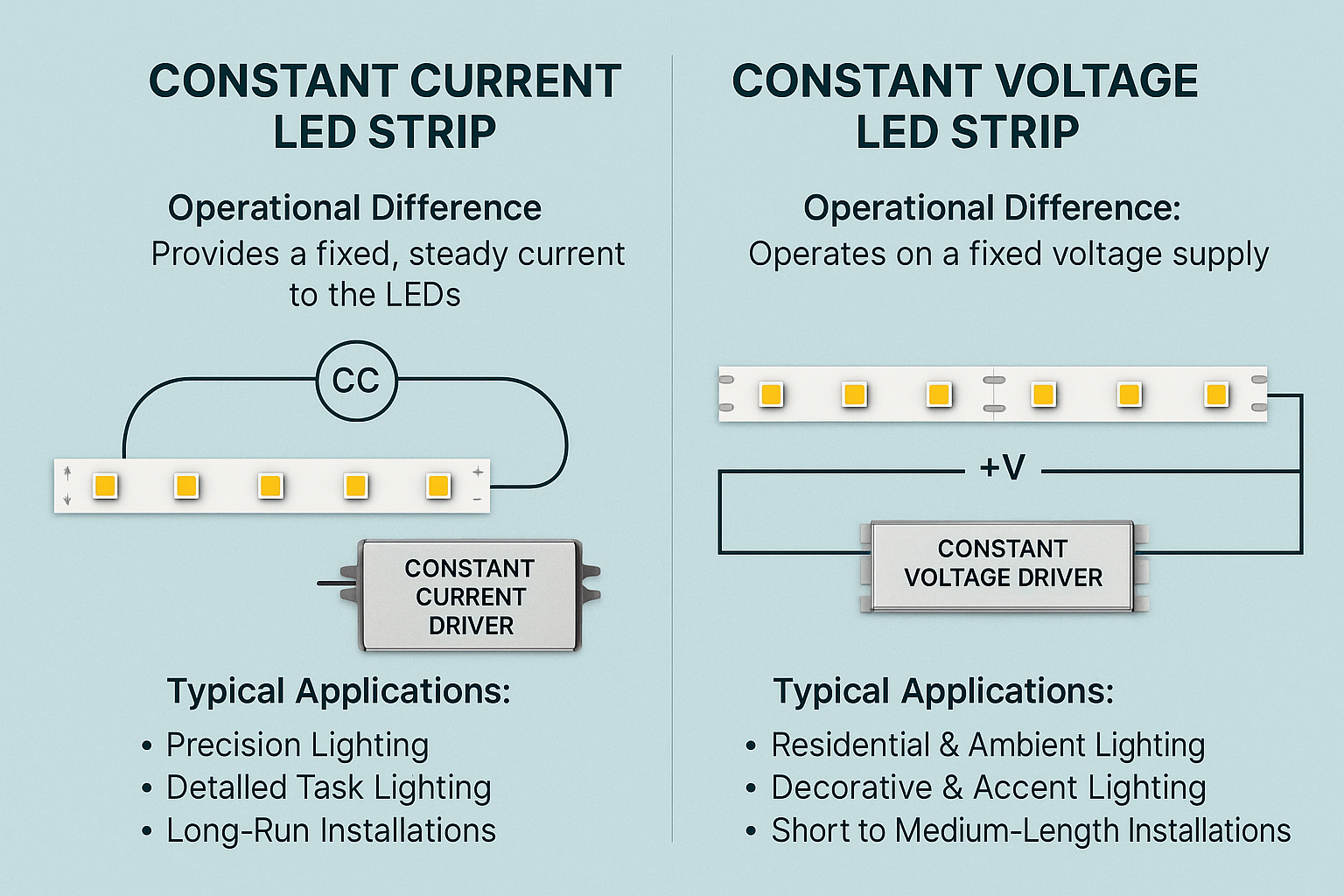
Key Technical Differences Clearly Explained
When choosing between constant current and constant voltage LED strips, understanding the technical differences is essential. From my own installations, I’ve noticed clear distinctions in their operation, brightness performance, and efficiency.
Current & Voltage Principles
- Constant Current LED Strips:
These provide a fixed, stable current, ensuring each LED consistently receives the exact amount of current needed, regardless of voltage variations. This stability leads to uniform brightness and longer lifespan.
- Constant Voltage LED Strips:
These operate on a fixed voltage supply, typically 12V or 24V. LEDs are connected in parallel, allowing easier expansion and installation flexibility, although variations in brightness can occur over longer distances due to voltage drop.
Brightness and Lighting Consistency
- Constant Current LED Strips:
Offer highly consistent brightness across the entire strip, making them perfect for professional, precision-focused lighting setups where uniformity is critical.
- Constant Voltage LED Strips:
Generally provide good brightness but may experience slight inconsistencies due to voltage drops, particularly noticeable in extended runs without proper planning.
Efficiency and Power Usage
- Constant Current LED Strips:
Highly efficient for installations requiring consistent brightness and reduced power consumption, particularly in professional lighting environments.
- Constant Voltage LED Strips:
Provide excellent efficiency for shorter runs or decorative setups. However, efficiency can reduce slightly over longer distances due to voltage drop issues.
A frequent question I encounter is, “What exactly is the difference between constant current and constant voltage LED drivers?” Simply put, constant current drivers regulate current to provide stable brightness, whereas constant voltage drivers maintain stable voltage, allowing easier, more flexible installations.
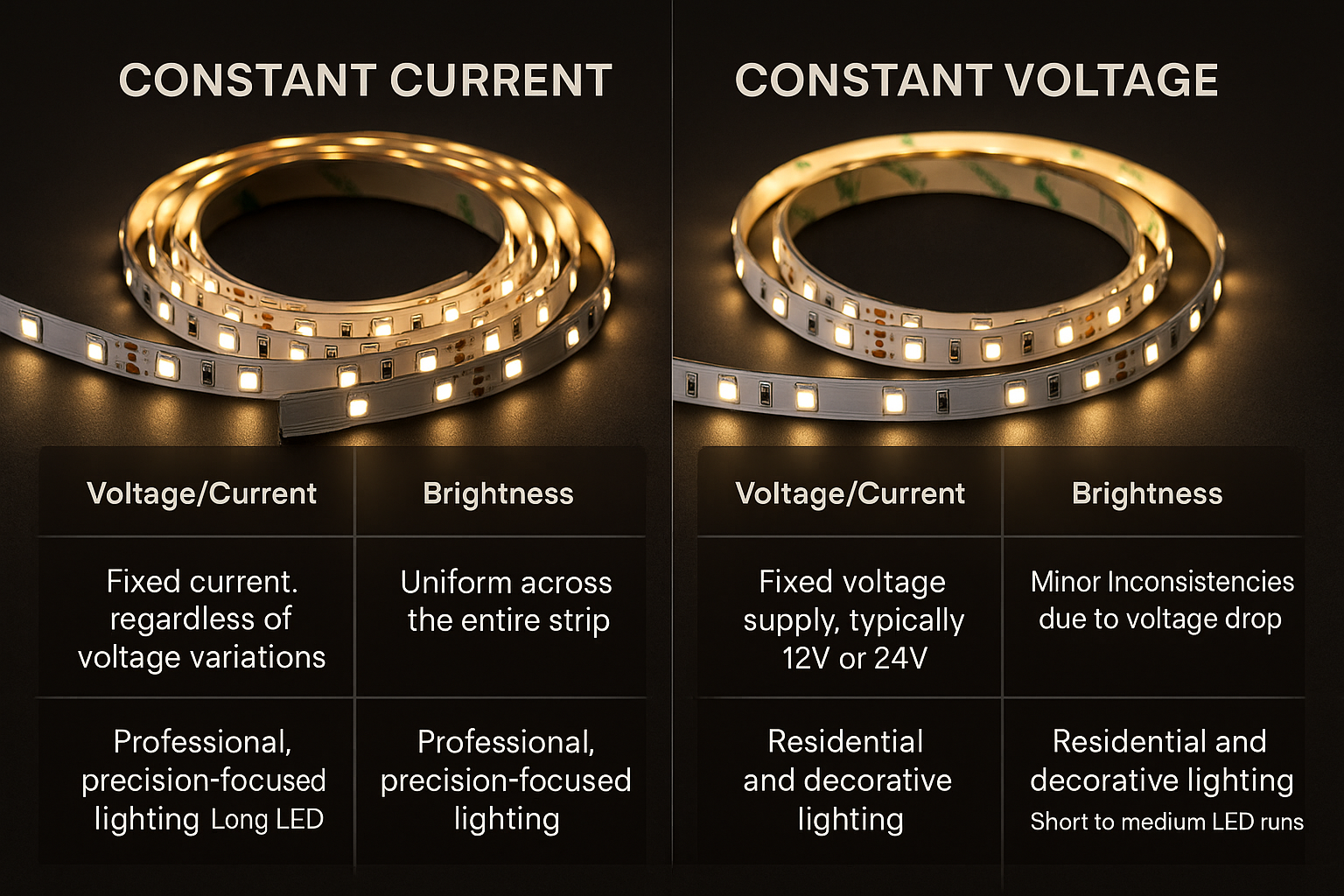
Safety & Reliability Considerations
In my experience with installing various LED strips, safety and reliability are critical factors. Clearly understanding how constant current and constant voltage LED strips differ in terms of these considerations can save you from potential risks and costly mistakes.
Safety Factors for Constant Current LED Strips
- Enhanced Stability and Safety:
Because constant current drivers maintain a stable current flow, they significantly reduce the risk of overheating or LED burnout. This consistency makes them especially safe and reliable for precise lighting installations.
- Professional Installation Recommended:
Given their technical nature, constant current setups usually require careful handling and professional installation to ensure optimal safety and performance.
Safety Considerations for Constant Voltage LED Strips
- Ease of Installation & Handling:
Constant voltage strips are generally safer for DIY or casual installations, provided proper voltage supplies and polarity are clearly observed.
- Voltage Drop Cautions:
Longer runs may encounter voltage drops, potentially causing inconsistent brightness or strain on the power supply, thus necessitating clear planning and careful management.
People often ask, “Which is safer: constant current or constant voltage?” From my practical experience, constant current setups generally provide superior safety due to their regulated current, particularly for professional or high-precision installations. Constant voltage setups, however, are safer and more convenient for casual, short-distance applications, provided proper handling and installation.
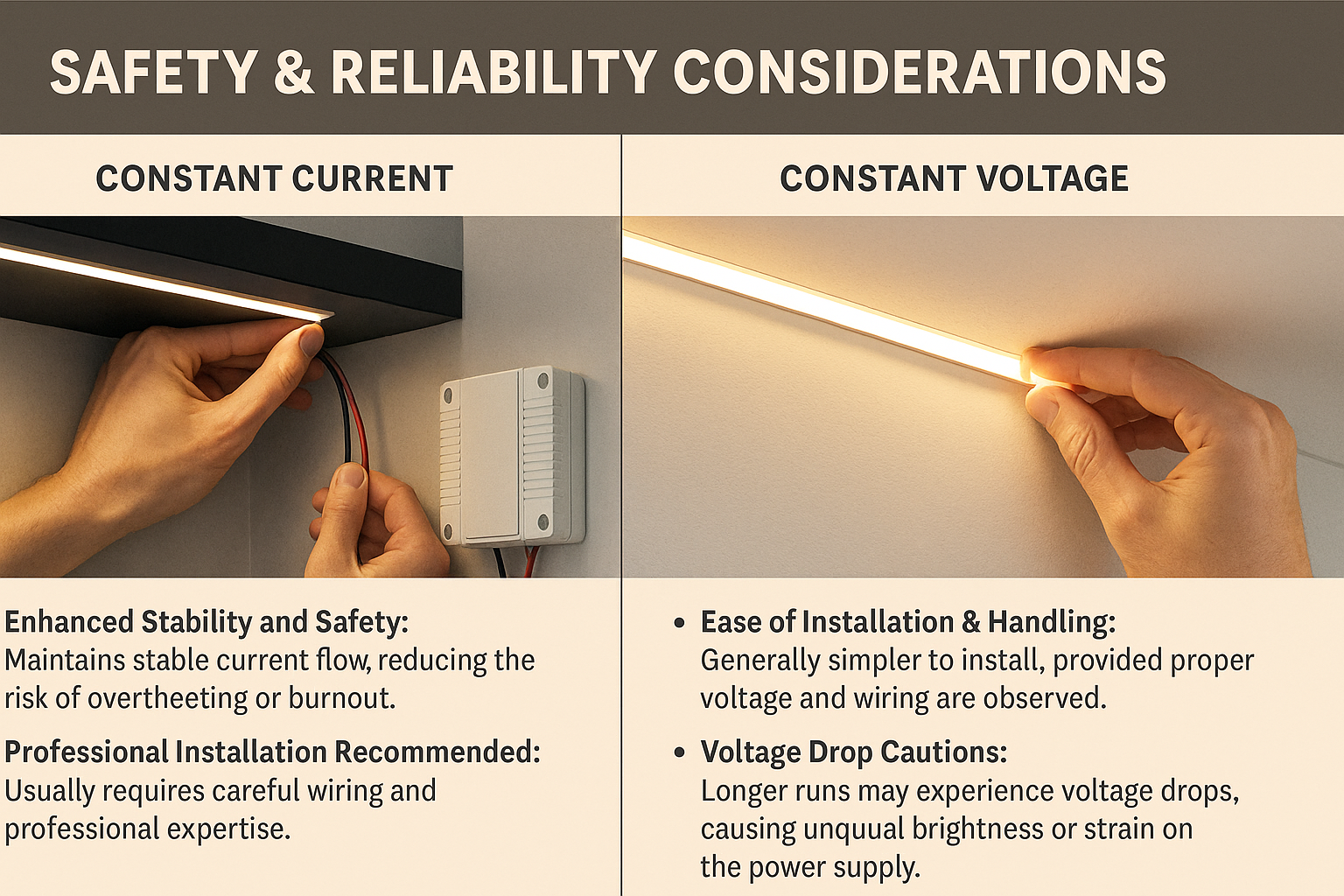
Advantages and Disadvantages of Constant Current LED Strips
Drawing from my extensive experience, I can clearly outline both the benefits and limitations of constant current LED strips. Understanding these can help you determine whether this type of LED strip is the right fit for your specific lighting project.
Advantages of Constant Current LED Strips
- Consistent Brightness:
Constant current strips provide uniform brightness across all LEDs, essential for professional, detailed lighting installations.
- Longer LED Lifespan:
Stable current reduces the risk of overheating, significantly enhancing the reliability and longevity of the LEDs.
- Enhanced Reliability:
These strips maintain optimal performance despite potential fluctuations in voltage, making them ideal for critical lighting projects.
Disadvantages of Constant Current LED Strips
- Increased Complexity:
Typically require precise wiring and specialized LED drivers, which can complicate installation and increase initial setup costs.
- Limited Flexibility:
Less suited for casual or DIY applications due to the need for professional installation and carefully matched drivers.
People often ask, “Do LED strips need constant current or constant voltage?” From my experience, if your lighting project requires detailed accuracy, consistent brightness, and long-term reliability, constant current LED strips are your best choice.
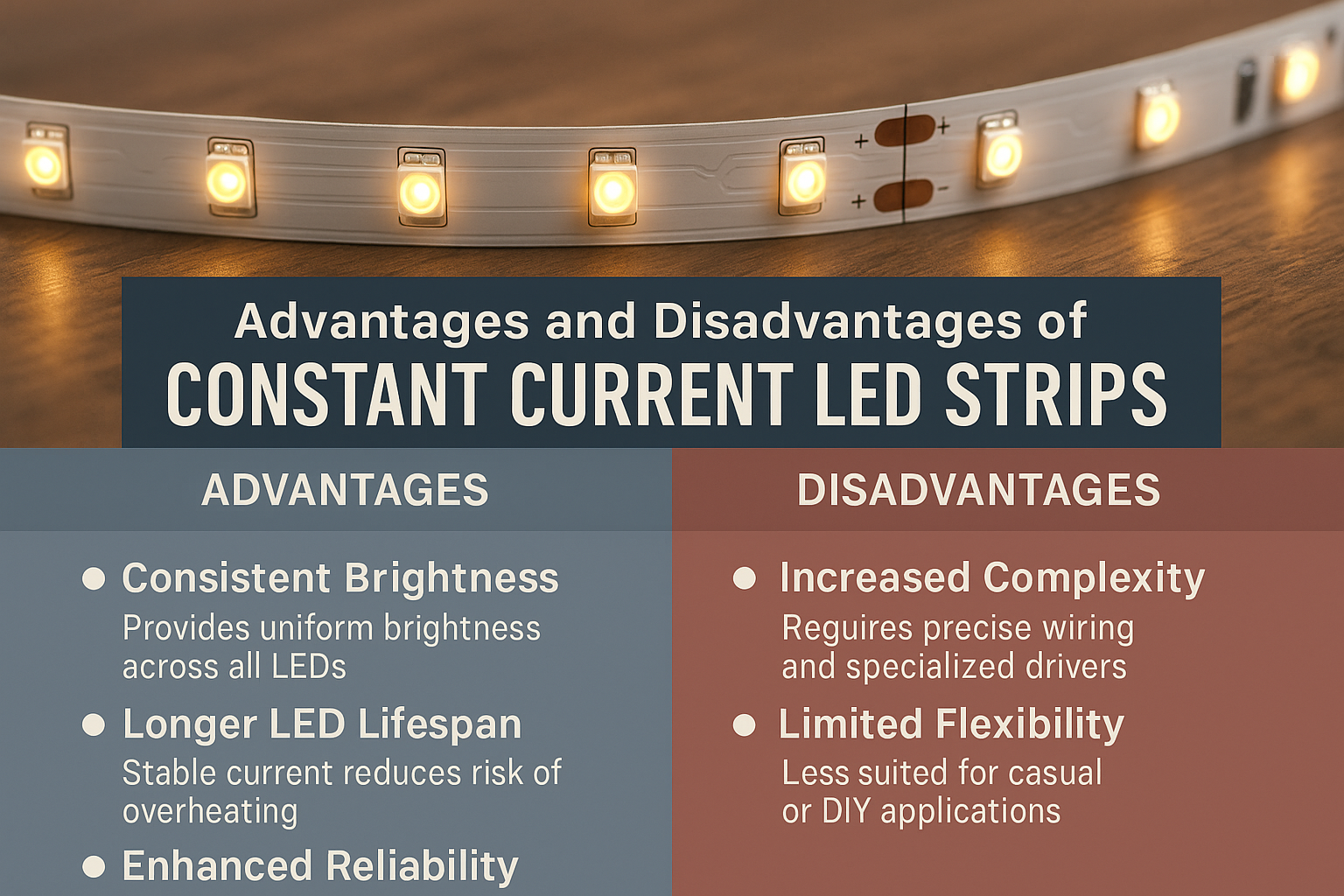
Best Applications & Ideal Scenarios
Having installed various types of LED strip lighting, I can clearly guide you toward understanding when and where constant current and constant voltage LED strips each perform best. Here are practical recommendations based on my own experience.
Ideal Uses for Constant Current LED Strips
Constant current LED strips are clearly ideal for situations that require precision lighting and consistent brightness, including:
- Professional Lighting Projects:
Architectural or display lighting where precise illumination consistency is crucial.
- Detailed Task Lighting:
Workshops, laboratories, offices, or any environment requiring consistent, reliable brightness levels.
- Long-Run Installations:
Projects where uniform brightness across long distances is essential.
Ideal Uses for Constant Voltage LED Strips
Constant voltage LED strips are particularly well-suited for flexible, less technically demanding installations, such as:
- Residential and Ambient Lighting:
Living rooms, bedrooms, kitchens, and general home lighting setups.
- Decorative & Accent Lighting:
Cabinets, furniture accents, indirect lighting, and creative installations where flexibility and ease of installation matter.
- Short to Medium-Length Installations:
Projects not requiring extensive lengths, ensuring brightness consistency remains manageable.
People often ask me, “Which LED strip type should I choose for typical home use?” Clearly, constant voltage LED strips are generally the better choice due to their ease of installation, cost-effectiveness, and flexibility for residential lighting projects.
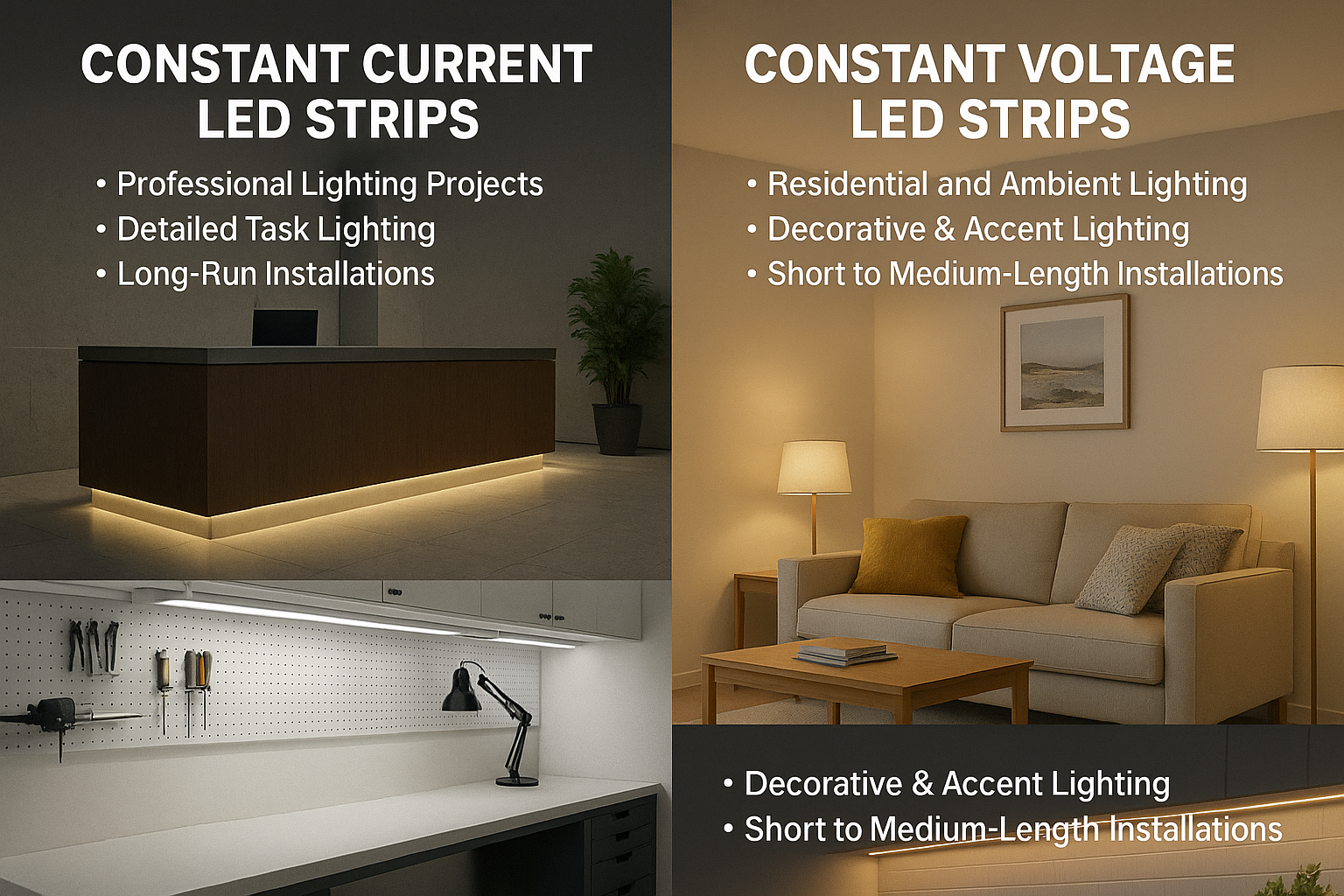
How to Choose Between Constant Current and Constant Voltage LED Strips
Having personally handled numerous LED lighting installations, I understand that choosing between constant current and constant voltage LED strips can feel overwhelming. Here’s my straightforward guide based on practical experience, clearly outlining key decision-making factors to help you choose confidently.
Key Factors to Consider
- Brightness & Consistency Needs:
If uniform brightness across longer runs or precise illumination is critical, constant current LED strips are clearly your best choice.
- Installation Complexity:
For simple, flexible, or DIY-friendly installations, constant voltage LED strips clearly provide easier handling and setup.
- Project Scale & Length:
Consider constant current strips for longer, professional-level installations requiring consistent brightness. For shorter or general residential setups, constant voltage strips typically suffice.
- Budget and Cost Efficiency:
Constant voltage LED strips generally have lower upfront costs, clearly advantageous for budget-sensitive projects.
Common Mistakes and Practical Recommendations
- Ignoring Installation Complexity:
Clearly assess your installation capability. Constant current strips may require professional expertise, while constant voltage strips offer easier DIY handling.
- Underestimating Voltage Drop (Constant Voltage):
For longer runs of constant voltage LED strips, clearly plan for additional power supplies or shorter segments to maintain brightness consistency.
- Choosing Solely Based on Cost:
Consider long-term performance, reliability, and specific lighting needs rather than only upfront costs when deciding between constant current and constant voltage LED strips.
Clients frequently ask me, “Should I use constant current or constant voltage LED strips for my home?” Clearly, constant voltage strips are typically more practical and suitable for residential and decorative lighting applications due to their ease of installation and cost-effectiveness.
External Link:
LED Drivers: Constant Current vs. Constant Voltage – LEDSupply
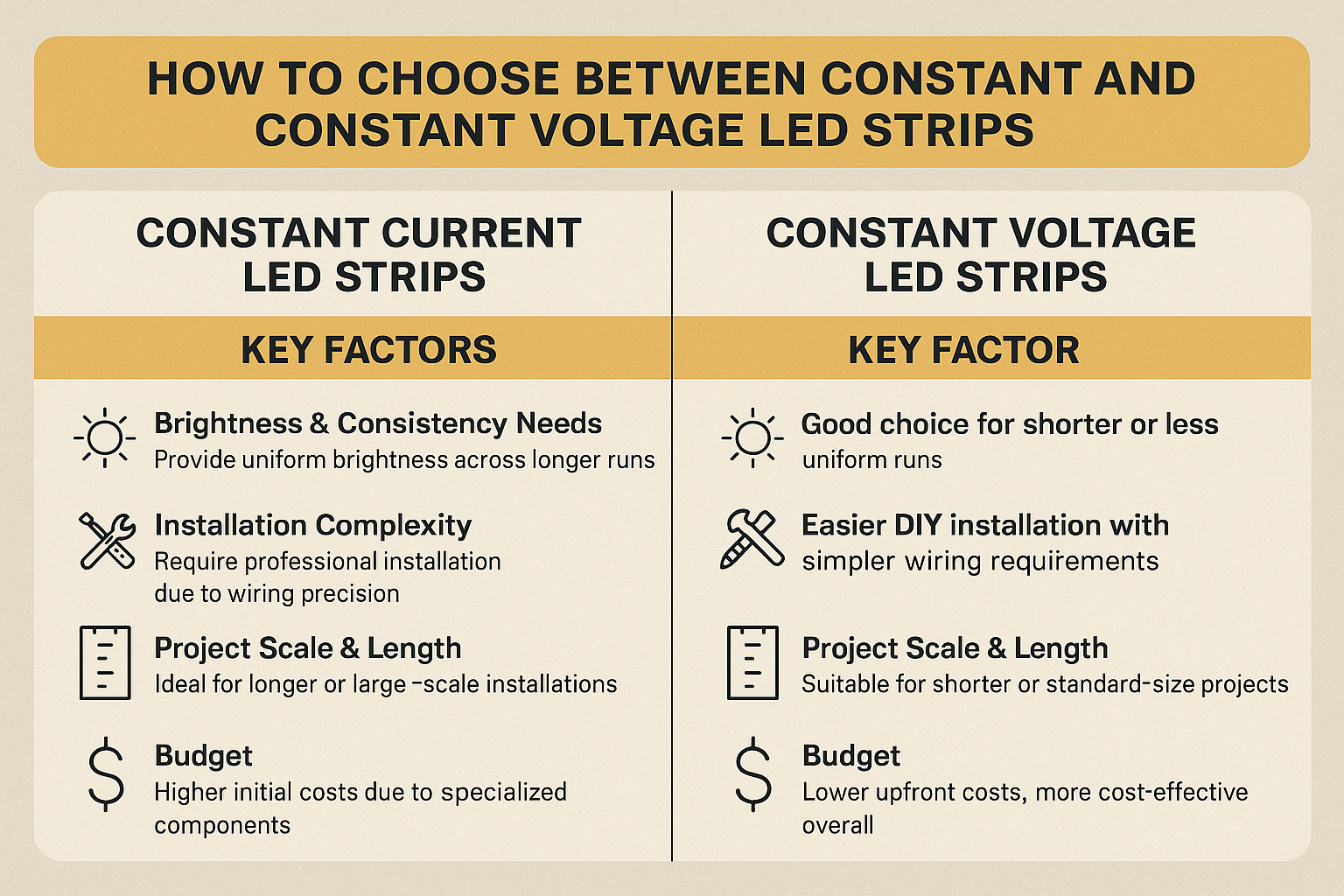
Installation, Maintenance & Expert Recommendations
Drawing from my extensive experience installing LED lighting, I clearly understand the practical considerations and challenges involved in handling constant current and constant voltage LED strips. Here’s a straightforward guide with installation instructions, essential maintenance practices, and practical troubleshooting tips to help you achieve optimal results.
Step-by-Step Installation Guide
Constant Current LED Strips Installation:
- Detailed Planning:
Clearly identify installation areas, considering appropriate driver compatibility and desired brightness levels.
- Professional Installation Recommended:
Constant current LED strips require precise wiring and compatible drivers. Always follow the manufacturer’s guidelines carefully.
- Secure Mounting:
Properly attach LED strips using mounting clips or channels designed to facilitate heat dissipation and secure installation.
- Testing and Adjustment:
Clearly verify connections, power compatibility, and brightness consistency thoroughly before completing installation.
Constant Voltage LED Strips Installation:
- Clear Surface Preparation:
Ensure surfaces are clean and dry before installing strips for optimal adhesion.
- Simple Mounting:
Peel adhesive backing and secure LED strips firmly, considering flexibility and ease of installation.
- Easy Connection:
Clearly connect to an appropriate constant voltage power supply, checking polarity and voltage carefully.
- Final Testing:
Power up the strips, clearly inspect lighting consistency, and make any necessary adjustments.
Essential Maintenance Practices
- Regular Inspections:
Periodically check connections, drivers, and LED strips for signs of wear, damage, or performance degradation.
- Effective Heat Management:
Ensure adequate heat dissipation, especially with constant current LED strips, using heat sinks, channels, or other cooling methods.
- Routine Cleaning:
Regularly clean LED strips gently with a dry cloth to maintain brightness and appearance.
Troubleshooting Common Issues
- Brightness Issues:
Check connections and power compatibility. Ensure proper matching of LED strips to the driver (constant current or voltage).
- Overheating:
Provide clear and sufficient heat dissipation solutions to prevent overheating, especially for constant current LED strips.
- LED Strips Not Lighting:
Verify connections, correct polarity, and suitable driver compatibility. Inspect power supplies and drivers regularly.
Many people ask me, “What common issues typically arise during LED strip installations?” From my experience, most common issues involve incorrect polarity connections, inadequate heat management, incompatible drivers, or insufficient power planning.
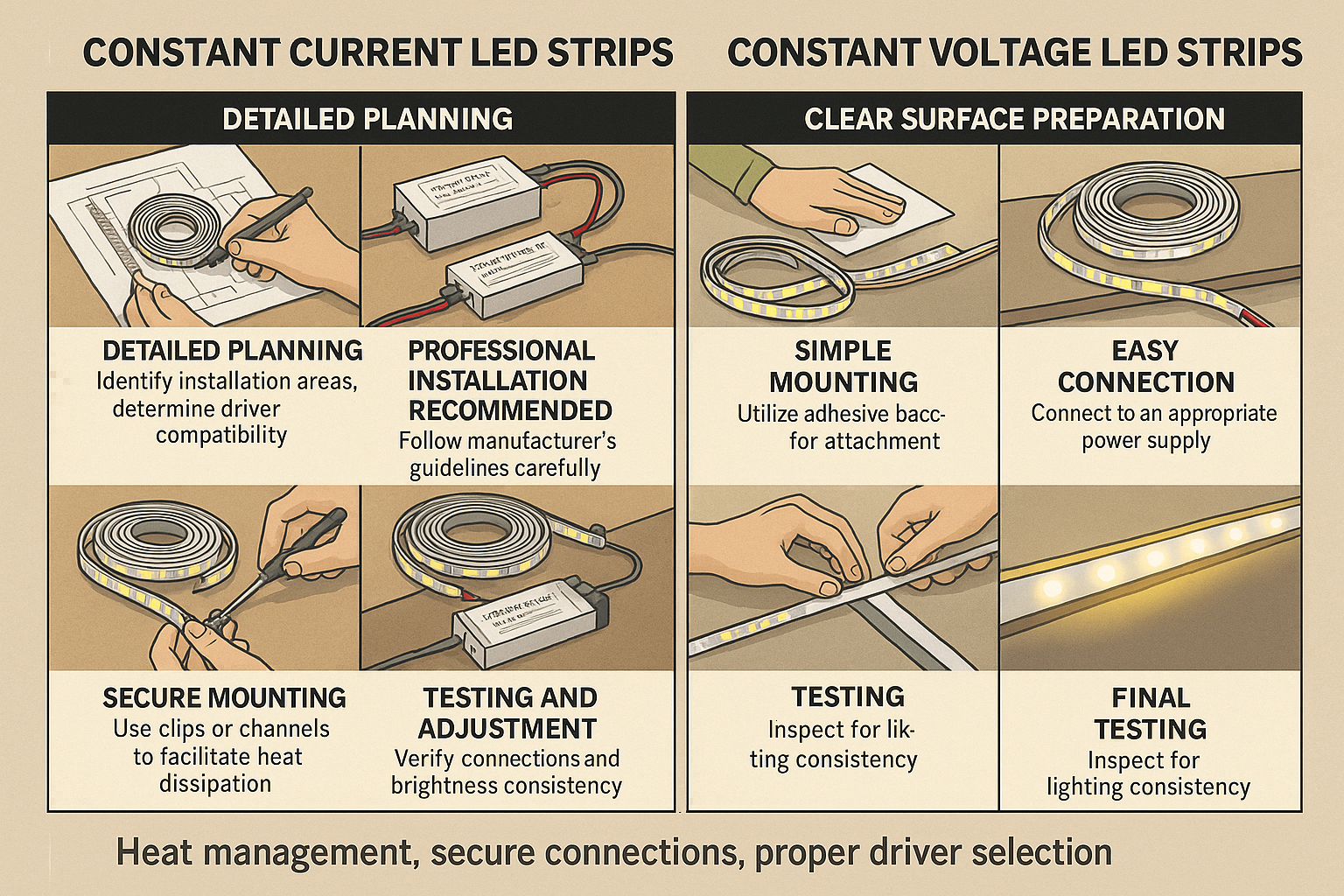
FAQs About Constant Current and Constant Voltage LED Strips
Here are clear, concise answers to some of the most frequent questions I receive about constant current and constant voltage LED strips. These insights will help you quickly resolve common doubts and confidently select the best lighting solution.
Do LED strips need constant current or constant voltage?
Generally, LED strips are designed for constant voltage operation due to ease of installation, flexibility, and lower cost. Constant current is typically preferred for professional, precise lighting setups where consistent brightness is crucial.
Which LED driver type is more efficient?
From my experience, constant current LED drivers are generally more efficient for maintaining consistent brightness, especially in longer runs or precision lighting applications. Constant voltage drivers offer good efficiency for general or shorter installations, though efficiency can decrease over longer lengths.
Can I interchange constant current and constant voltage drivers?
No, constant current and constant voltage LED strips are not interchangeable. Using the incorrect driver type can damage the LEDs, cause inconsistent lighting, or even pose safety hazards. Always match your LED strips to the appropriate driver clearly recommended by the manufacturer.
Conclusion & Next Steps
Clearly understanding the differences between constant current and constant voltage LED strips is essential to achieving optimal lighting results for your projects. If your project requires precise, consistent brightness and long-term reliability, constant current LED strips are clearly your best choice. For general lighting applications that demand flexibility, ease of installation, and cost-efficiency, constant voltage LED strips are ideal.
From my hands-on experience, carefully assessing your project’s specific needs—brightness consistency, installation complexity, budget, and performance requirements—will help you make a confident and informed decision.
Ready to select the perfect LED lighting solution?
Explore Elstar’s LED Lighting Solutions →








